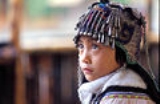
Hani people
Encyclopedia


People's Republic of China
China , officially the People's Republic of China , is the most populous country in the world, with over 1.3 billion citizens. Located in East Asia, the country covers approximately 9.6 million square kilometres...
. They also form one of the 54 officially recognized ethnic groups of Vietnam. There are 12,500 Hanis living in the Lai Chau
Lai Chau
Lai Châu is the capital town of Lai Chau province in the Northwest region of Vietnam....
and Lao Cai
Lao Cai Province
Lào Cai , is a province of northeastern in the mountainous region of Vietnam, bordering the province of Yunnan in the China. The province covers an area of 6383.9 square kilometres and as of 2008 it had a population of 602,300 people....
provinces of Vietnam
Vietnam
Vietnam – sometimes spelled Viet Nam , officially the Socialist Republic of Vietnam – is the easternmost country on the Indochina Peninsula in Southeast Asia. It is bordered by China to the north, Laos to the northwest, Cambodia to the southwest, and the South China Sea –...
.
Over ninety percent of the Hani live in the southwestern Chinese province of Yunnan
Yunnan
Yunnan is a province of the People's Republic of China, located in the far southwest of the country spanning approximately and with a population of 45.7 million . The capital of the province is Kunming. The province borders Burma, Laos, and Vietnam.Yunnan is situated in a mountainous area, with...
, scattered across the Ailao Mountains
Ailao Mountains
The Ailao Mountains are located in Yunnan, China. The Ailao Mountain Nature Reserve is located in the Ailao Mountains, is about 503.60 square kilometres and was created in 1986....
between the Mekong River and the Red River
Red River (Vietnam)
The Red River , also known as the Sông Cái - Mother River , or Yuan River , is a river that flows from southwest China through northern Vietnam to the Gulf of Tonkin...
(Yuanjiang).
The origins of the Hani are not precisely known, though their ancestors, the ancient Qiang tribe, are believed to have migrated southward from the Qinghai
Qinghai
Qinghai ; Oirat Mongolian: ; ; Salar:) is a province of the People's Republic of China, named after Qinghai Lake...
-Tibet
Tibet
Tibet is a plateau region in Asia, north-east of the Himalayas. It is the traditional homeland of the Tibetan people as well as some other ethnic groups such as Monpas, Qiang, and Lhobas, and is now also inhabited by considerable numbers of Han and Hui people...
an plateau prior to the third century AD.
The Hani oral traditions state that they are descended from the Yi people
Yi people
The Yi or Lolo people are an ethnic group in China, Vietnam, and Thailand. Numbering 8 million, they are the seventh largest of the 55 ethnic minority groups officially recognized by the People's Republic of China...
, and that they split off as a separate tribe fifty generations ago. One of their oral traditions is the recital of the names of Hani ancestors from the first Hani family down to oneself.
Religion
The Hani are polytheists and they profess a special adoration toward the spirits of their ancestors. They are used to practicing rituals to venerate to the different gods and thus to obtain their protection.The religious hierarchy of the Hani is divided into three main personages: the zuima that directs the main celebrations; the beima, responsible for practicing the exorcisms and the magical rituals; the nima that takes charge of carrying out predictions and to administer the medicinal herbs. This last charge can be performed indistinctly by men and women. Some Hani also profess Theravada Buddhism.
Culture
The dwellings of the Hani are usually two or three stories high, built with bamboo, mud, stone and wood.The traditional clothing of the Hani is used made out of dark blue fabric. The men dress in short jackets and in long wide pants. They also wear turbans which are white or black. The women dress depending on which clan they belong to. There is no gender difference in the clothing of children under the age of seven.
They play a wind instrument called the ebi (俄比).
Part of thousand years old culture are terraced
Terrace (agriculture)
Terraces are used in farming to cultivate sloped land. Graduated terrace steps are commonly used to farm on hilly or mountainous terrain. Terraced fields decrease erosion and surface runoff, and are effective for growing crops requiring much water, such as rice...
fields.
Language
The Hani languageHani language
The Hani language is a language of the Loloish branch of the Tibeto-Burman linguistic group spoken in China, Laos, Burma , and Vietnam by the Hani people.-Dialects:Hani proper has three dialects: Haya, Haohai, and Bika...
spoken by many of the Hani is of the Yi branch of the Tibeto-Burman language family. Oral tradition tells of an ancient written script, tradition says it was lost on the migration from Sichuan. They now use a romanization of the Luchun dialect as a written script.
See also

- Honghe Hani and Yi Autonomous PrefectureHonghe Hani and Yi Autonomous PrefectureHonghe Hani and Yi Autonomous Prefecture is an autonomous prefecture of Yunnan Province, China. Its name is derived from the Honghe river and the two major ethnic minority groups who live there: the Yi and the Hani. Honghe has an area of 32,929 km²...
- Yuanyang County, Yunnan, with its Hani majority and immense rice terraced mountains
External links
- Photographs of the Hani of Yuanyang County, Yunnan
- Hani gallery
- The Hani ethnic minority on China.org.cn (Chinese government site)
- Asia harvest ethnic profile
- ハニ和辞典 (Hani-Japanese glossary)
- UNESCO about terrace fields

